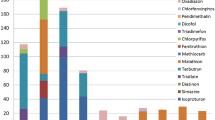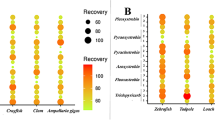Abstract
As the consumption of aquatic products increased, the need for regulation of pesticide residues in aquatic products also emerged. Thus, in this study, a scheduled multiple reaction monitoring (sMRM) method employing a novel extraction and purification step based on QuEChERS with EDTA was developed for the simultaneous quantitation of 20 pesticides (alachlor, aldicarb, carbofuran, diazinon, dimethoate, dimethomorph, ethoprophos, ferimzone, fluridone, hexaconazole, iprobenfos, malathion, methidathion, methiocarb, phenthoate, phosalone, phosmet, phosphamidon, pirimicarb, and simazine) in aquatic products. Additionally, the present method was validated in the aspects of specificity, linearity (r ≥ 0.980), sensitivity (the limit of quantitation (LOQ) ≤ 5 ng/g), relative standard deviation, RSD (1.0 % ≤ RSD ≤ 19.4 %), and recovery (60.1 % ≤ recovery ≤ 117.9 %). Finally, the validated method was applied for the determination of the 20 pesticide residues in eel and shrimp purchased from local food markets. In the present study, QuEChERS with EDTA was successfully expanded to residual pesticide analysis for the first time. The present method could contribute to the rapid and successful establishment of the positive list system in South Korea.


Similar content being viewed by others
References
Reemtsma T, Jekel M (2006) Organic pollutants in the water cycle. Wiley-VCH Verlag GmBH & Co. KGaA, Weinheim
Loos R, Gawlik BM, Locoro G, Rimaviciute E, Contini S, Bidoglio G (2009) EU-wide survey of polar organic persistent pollutants in European river waters. Environ Pollut 157:561–568
Devault DA, Gérino M, Laplanche C, Julien F, Winterton P, Merlina G, Delmas F, Lim P, Miguel Sánchez-Pérez J, Pinelli E (2009) Herbicide accumulation and evolution in reservoir sediments. Sci Total Environ 407:2659–2665
John PJ, Prakash A (2003) Bioaccumulation of pesticides on some organs of freshwater catfish Mystus vittatus. Bull Environ Contam Toxicol 70:1013–1016
Sun F, Wong SS, Li GC, Chen SN (2006) A preliminary assessment of consumer’s exposure to pesticide residues in fisheries products. Chemosphere 62:674–680
FAO (Food and Agriculture Organization of the United Nations) (2007) The state of world fisheries and aquaculture-2006 Part 1 world review of fisheries and aquaculture. FAO Fisheries and Aquaculture Department, Rome
Annual consumption of aquatic products in South Korea (2014) Available at http://www.index.go.kr/potal/main/EachDtlPageDetail.do?idx_cd=1317
Lazartigues A, Thomas M, Cren-Olivé C, Brun-Bellut J, Le Roux Y, Banas D, Feidt C (2013) Pesticide pressure and fish farming in barrage pond in Northeastern France. Part II: residues of 13 pesticides in water, sediments, edible fish and their relationships. Environ Sci Pollut Res 20:117–125
Lazartigues A, Thomas M, Banas D, Brun-Bellut J, Cren-Olivé C, Feidt C (2013) Accumulation and half-lives of 13 pesticides in muscle tissue of freshwater fishes through food exposure. Chemosphere 91:530–535
The European Community (2005) Regulation (EC) No 396/2005 of the European parliament and of the council of 23 February 2005 on maximum residue levels of pesticides in or on food and feed of plant and animal origin and amending Council Directive 91/414/EEC. Off Eur Commun L70:1–16
Department of Food Safety, Ministry of Health, Labour and Welfare, Japan (2006) Introduction of the positive list system for agricultural chemical residues in foods. Available at http://www.mhlw.go.jp/english/topics/foodsafety/positivelist060228/introduction.html
Alder L, Greulich K, Kempe G, Vieth B (2006) Residue analysis of 500 high priority pesticides: better by GC-MS or LC-MS/MS? Mass Spectrom Rev 25:838–865
Botero-Coy AM, Marín JM, Ibáñez M, Sancho JV, Hernández F (2012) Multi-residue determination pesticides in tropical fruits using liquid chromatography/tandem mass spectrometry. Anal Bioanal Chem 402:2287–2300
Hernández F, Pozo OJ, Sancho JV, Bijlsma L, Barreda M, Pitarch E (2006) Multiresidue liquid chromatography tandem mass spectrometry determination of 52 non gas chromatography-amenable pesticides and metabolites in different food commodities. J Chromatogr A 1109:242–252
Lazartigues A, Fratta C, Baudot R, Wiest L, Feidt C, Thomas M, Cren-Olivé C (2011) Multiresidue method for the determination of 13 pesticides in three environmental matrices: water, sediments and fish muscle. Talanta 85:1500–1507
Sapozhnikova Y (2014) Evaluation of low-pressure gas chromatography-tandem mass spectrometry method for the analysis of >140 pesticides in fish. J Agric Food Chem 62:3684–3689
Nardelli V, Dell’Oro D, Palermo C, Centonze D (2010) Multi-residue method for the determination of organochlorine pesticides in fish feed based on a cleanup approach followed by gas chromatography-triple quadrupole tandem mass spectrometry. J Chromatogr A 1217:4996–5003
Serrano R, Barreda M, Pitarch E, Hernández F (2003) Determination of low concentrations of organochlorine pesticides and PCBs in fish feed and fish tissues from aquaculture activities by gas chromatography with tandem mass spectrometry. J Sep Sci 26:75–86
Weichbrodt M, Vetter W, Luckas B (2000) Microwave-assisted extraction and accelerated solvent extraction with ethyl acetate-cyclohexane before determination of organochlorines in fish tissue by gas chromatography with electron-capture detection. J AOAC Int 83:1334–1343
Ghosh R, Hageman KJ, Björklund E (2011) Selective pressurized liquid extraction of three classes of halogenated contaminants in fish. J Chromatogr A 1218:7242–7247
Jordan TB, Nichols DS, Kerr NI (2009) Selection of SPE cartridge for automated solid-phase extraction of pesticides from water followed by liquid chromatography-tandem mass spectrometry. Anal Bioanal Chem 394:2257–2266
Liu X, Guan W, Hao X, Wu X, Ma Y, Pan C (2014) Pesticide multi-residue analysis in tea using d-SPE sample cleanup with graphene mixed with primary secondary amine and graphitized carbon black prior to LC-MS/MS. Chromatographia 77:31–37
Anastassiades M, Lehotay SJ, Stajnbaher D, Schenck FJ (2003) Fast and easy multiresidue method employing acetonitrile extraction/partitioning and “dispersive solid phase extraction” for the determination of pesticides residues in produce. J AOAC Int 86:412–431
Rawn DFK, Judge J, Roscoe V (2010) Application of the QuEChERS method for the analysis of pyrethrins and pyrethroids in fish tissues. Anal Bioanal Chem 397:2525–2531
Lazartigues A, Wiest L, Baudot R, Thomas M, Feidt C, Cren-Olivé C (2011) Multiresidue method to quantify pesticides in fish muscle by QuEChERS-based extraction and LC-MS/MS. Anal Bioanal Chem 400:2185–2193
EN 15662 method (2008) Foods of plant origin–determination of pesticide residues using GC-MS and/or LC-MS/MS following acetonitrile extraction/partitioning and clean-up by dispersive SPE-QuEChERS-method
Biselli S, Schwalb U, Meyer A, Hartig L (2013) A multi-class, multi-analyte method for routine analysis of 84 veterinary drugs in chicken muscle using simple extraction and LC-MS/MS. Food Addit Contam Part A 30:921–939
Agrochemical Year Book, Korea Crop Protection Association 2013
Ministry of food and drug safety, South Korea. Pesticides and Veterinary Drugs Information. Available at http://www.foodnara.go.kr/residue/main.do
The study on safety control of national pesticide residues for foods, The final report of 09072KFDA997, KFDA 2012
Pico Y, Molto JC, Redondo MJ, Viana E, Manes J, Font G (1994) Monitoring of the pesticides levels in natural waters of the Valencia Community (Spain). Bull Environ Contam Toxicol 53:230–237
Miliadis GE, Malatou PTH (1997) Monitoring of the pesticides levels in natural waters of Greece. Bull Environ Contam Toxicol 59:917–923
Charizopoulos E, Papadopoulou-Mourkidou E (1999) Occurrence of pesticides in rain of the Axios river basin, Greece. Environ Sci Technol 33:2363–2368
Narushima T, Sato T, Goto T, Takahashi Y (2014) Pesticides in river and tap water in a rice production area of Niigata, Japan. Water Air Soil Pollut 225:2229
Cha ES, Jeong M, Lee WJ (2014) Agricultural pesticides usage and prioritization in South Korea. J Agromedicine 19:281–293
The WHO Recommended Classification of Pesticides by Hazard and Guidelines to Classification 2009, World Health Organization 2010
Ministry of food and drug safety, South Korea. Food and nutrient data system. Available at http://www.foodnara.go.kr/kisna/index.do
Codex Committee on Pesticide Residues (CCPR) Guidelines on good laboratory practice in pesticide residue analysis CAC/GL 40–1993
Subramaniam V, Hoggard PE (1988) Metal complexes of glyphosate. J Agric Food Chem 36:1326–1329
Critical Survey of Stability Constants of EDTA Complexes. IUPAC Chemical data series-No.14, IUPAC 1977
NF V03-061; NF EN 15662:2009-01-01 Foods of plant origin―determination of pesticide residues using GC-MS and/or LC-MS/MS following acetonitrile extraction/partitioning and clean-up by dispersive SPE-QuEChERS-method
Pang GF, Cao YZ, Fan CL, Jia GQ, Zhang JJ, Li XM, Liu YM, Shi YQ, Li ZY, Zheng F, Lian YJ (2009) Analysis method study on 839 pesticides and chemical contaminant multiresidues in animal muscles by gel permeation chromatography cleanup, GC/MS, and LC/MS/MS. J AOAC Int 92:S1–S72
Acknowledgments
We gratefully thank Dr. Tae-Hyun Kim (Soonchunhyang Univeristy) for technical advice. This research was supported by a grant (14162MFDS854) from Ministry of Food and Drug Safety, Republic of Korea in 2014.
Author information
Authors and Affiliations
Corresponding author
Ethics declarations
Conflict of interest
The authors declare that they have no conflict of interest.
Rights and permissions
About this article
Cite this article
Cho, H.R., Park, J.S., Kim, J. et al. Multiresidue method for the quantitation of 20 pesticides in aquatic products. Anal Bioanal Chem 407, 9043–9052 (2015). https://doi.org/10.1007/s00216-015-9071-x
Received:
Revised:
Accepted:
Published:
Issue Date:
DOI: https://doi.org/10.1007/s00216-015-9071-x




